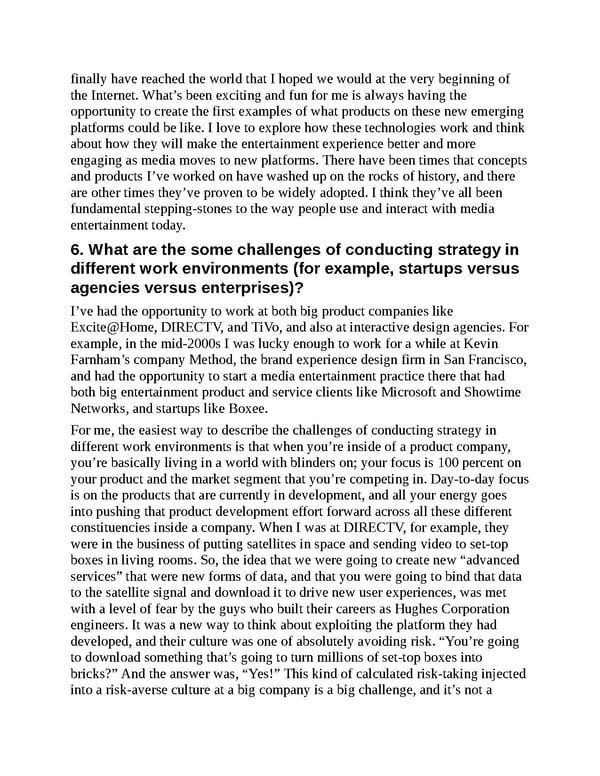finally have reached the world that I hoped we would at the very beginning of the Internet. What’s been exciting and fun for me is always having the opportunity to create the first examples of what products on these new emerging platforms could be like. I love to explore how these technologies work and think about how they will make the entertainment experience better and more engaging as media moves to new platforms. There have been times that concepts and products I’ve worked on have washed up on the rocks of history, and there are other times they’ve proven to be widely adopted. I think they’ve all been fundamental stepping-stones to the way people use and interact with media entertainment today. 6. What are the some challenges of conducting strategy in different work environments (for example, startups versus agencies versus enterprises)? I’ve had the opportunity to work at both big product companies like Excite@Home, DIRECTV, and TiVo, and also at interactive design agencies. For example, in the mid-2000s I was lucky enough to work for a while at Kevin Farnham’s company Method, the brand experience design firm in San Francisco, and had the opportunity to start a media entertainment practice there that had both big entertainment product and service clients like Microsoft and Showtime Networks, and startups like Boxee. For me, the easiest way to describe the challenges of conducting strategy in different work environments is that when you’re inside of a product company, you’re basically living in a world with blinders on; your focus is 100 percent on your product and the market segment that you’re competing in. Day-to-day focus is on the products that are currently in development, and all your energy goes into pushing that product development effort forward across all these different constituencies inside a company. When I was at DIRECTV, for example, they were in the business of putting satellites in space and sending video to set-top boxes in living rooms. So, the idea that we were going to create new “advanced services” that were new forms of data, and that you were going to bind that data to the satellite signal and download it to drive new user experiences, was met with a level of fear by the guys who built their careers as Hughes Corporation engineers. It was a new way to think about exploiting the platform they had developed, and their culture was one of absolutely avoiding risk. “You’re going to download something that’s going to turn millions of set-top boxes into bricks?” And the answer was, “Yes!” This kind of calculated risk-taking injected into a risk-averse culture at a big company is a big challenge, and it’s not a
 UX Strategy: How to Devise Innovative Digital Products that People Want Page 316 Page 318
UX Strategy: How to Devise Innovative Digital Products that People Want Page 316 Page 318